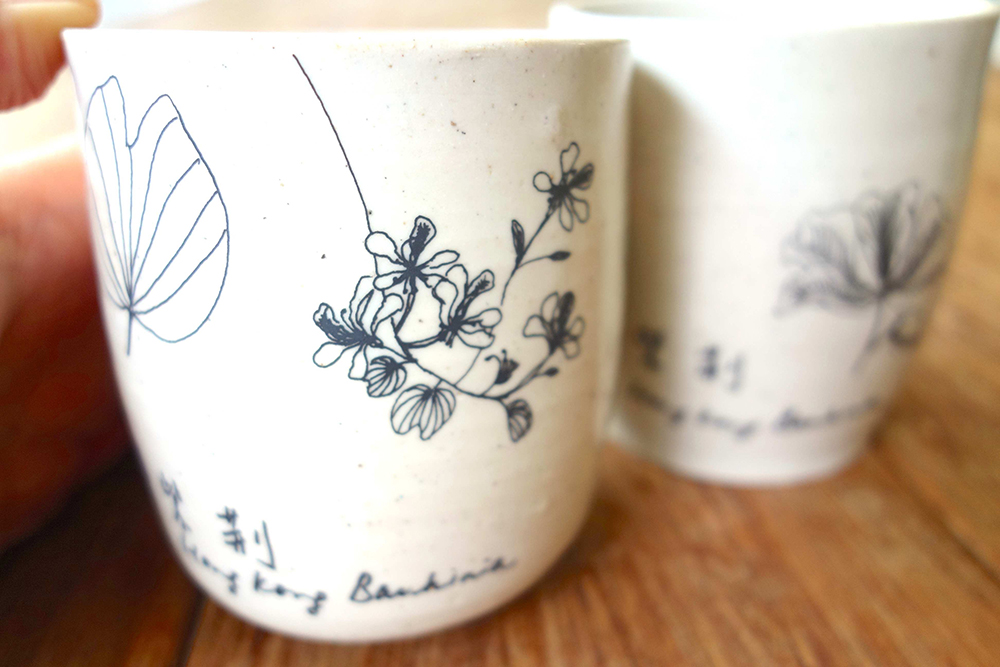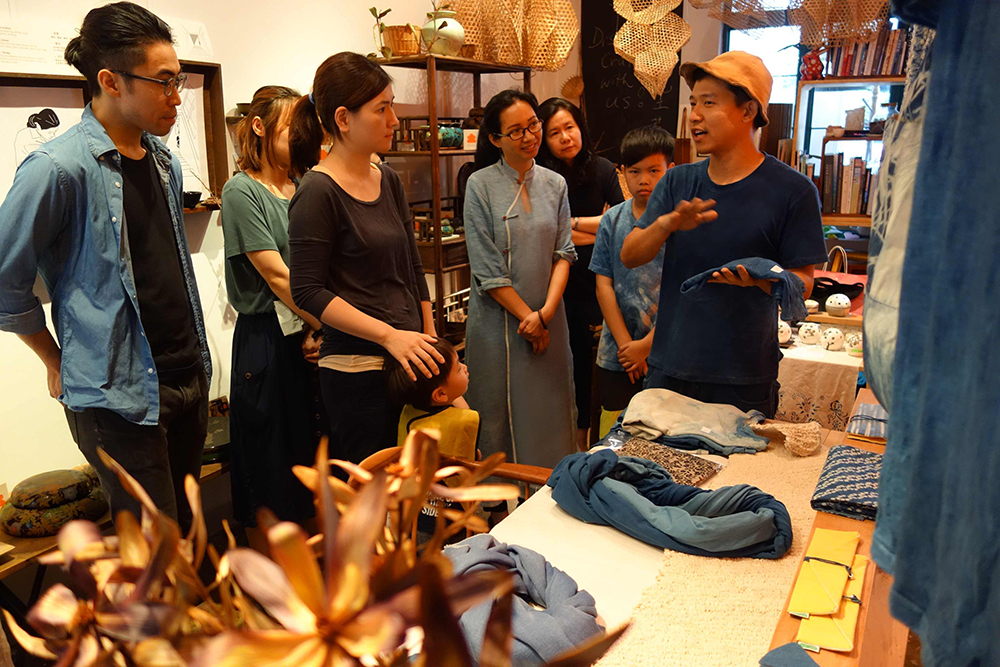NEWS & EVENTS > INTERVIEW
"A nation's culture resides in the hearts and in the soul of its people"
-Mahatma Ghandi
Susanna Pang — Founder of SOIL
August 2017

Premium Lacquerware Magnolia by lacquer master Veronica Gritsenko, Black Elephant Studio for SOIL
August 2017

Premium Lacquerware Magnolia by lacquer master Veronica Gritsenko, Black Elephant Studio for SOIL
In your store, there are many different types of handicrafts. What criteria do you follow in selecting which pieces to introduce to the store?
Lacquerware make up our main products, and we invest the most resources into them. I go to Myanmar twice or three times a year. We work with a partner who is Ukrainian designer who has lived in Myanmar for about 15 years, and together we will brainstorm new lacquer design ideas, which are then produced in Myanmar. We also work with a Taiwanese artist, on a series of lacquer chopsticks made in Taiwan. We have also been exploring the lacquer industry in China. We have been to Fuzhou, and we worked with the artists in Fuzhou to produce small lacquer boxes. We do not mass produce the pieces, since we want to ensure the quality of each lacquer product. Besides, we also worked with a Taiwanese artist. There is a series of lacquer chopsticks made in Taiwan. We also tried to explore the lacquer industry in China. We have been Fuzhou. We worked with the artists in Fuzhou and produce a small lacquer box. We do not do mass production since we want to ensure the quality of every lacquer products as it requires a lot of time and processes. We want to explore the possibilities of lacquerware.
In terms of the criteria on how we choose products, we also have other categories of products besides lacquerware. We sell ceramics, including hand-painted ceramics. We hope to attract foreigners. Even if they may not know much about local traditional handicrafts, they can still be attracted by patterns such as roosters, flowers from Hong Kong, and from there learn more about the traditional cultures of Hong Kong. For example, previously we have worked with Peng Chau Chiu Kee Porcelain Factory. Even many local Hong Kong people may not know this, but Peng Chau is an island that used to have many small factories that produced porcelain. The hope is to garner’s people interest in a place or culture through a handicraft. We hope that each product in our store can have this effect.
Can you share with us one of the more successful exhibitions that SOIL has held?
We have held more than ten exhibitions at PMQ in the past few years. I don’t dare say whether or not they were successful, but if were talking about an exhibition that really aligns with SOIL’s philosophy, then I would choose “Painted in Peng Chau.” “Painted in Peng Chau” was held in July 2014, and we had chosen Peng Chau as a starting point in which to look at the handicraft history of Hong Kong. At first, we were only going to shoot a film about Chiu Kee Porcelain in Peng Chau—we didn’t really have thoughts about holding an exhibition. Chiu Kee Porcelain is the porcelain shop of Mr Lam and his wife. The 1960s to 70s was the golden age of Chiu Kee, when thirty to forty workers were employed in the shop. We started shooting in 2013. After the opening of SOIL, we decided that we wanted to hold an exhibition based on the film. This exhibition was an unforgettable experience. In July, Mr Lam and Mrs Lam attended the exhibition with a lot of joy, but Mr. Lam passed away three days after the closing of the exhibition. We never thought that this exhibition would be the last exhibition of Mr Lam. It made us realize that life is hard to predict, and also left us with the deep impression that these traditional handicrafts can come to an end. For example, the hand-painted rooster pattern is the representative work of Mr Lam, that no other artisan in Hong Kong can draw—those that can are older in age, and are no longer engaged in the craft. I think that this exhibition achieved its goals. First of all, most of the products were sold. And through the reports of various media, discussions about porcelain and Guangcai were raised among the public. We received positive responses about the exhibition, and it also led to new design ideas. In 2015, we held an exhibition called “Something East, Something West”. By inviting century-old established brands—for example Wah Tung China, and an old craftsman from the Yuet Tung China Works—to participate, we were able to draw the links between Peng Chau and the bigger picture of the development of Guangcai.
Lacquerware make up our main products, and we invest the most resources into them. I go to Myanmar twice or three times a year. We work with a partner who is Ukrainian designer who has lived in Myanmar for about 15 years, and together we will brainstorm new lacquer design ideas, which are then produced in Myanmar. We also work with a Taiwanese artist, on a series of lacquer chopsticks made in Taiwan. We have also been exploring the lacquer industry in China. We have been to Fuzhou, and we worked with the artists in Fuzhou to produce small lacquer boxes. We do not mass produce the pieces, since we want to ensure the quality of each lacquer product. Besides, we also worked with a Taiwanese artist. There is a series of lacquer chopsticks made in Taiwan. We also tried to explore the lacquer industry in China. We have been Fuzhou. We worked with the artists in Fuzhou and produce a small lacquer box. We do not do mass production since we want to ensure the quality of every lacquer products as it requires a lot of time and processes. We want to explore the possibilities of lacquerware.
In terms of the criteria on how we choose products, we also have other categories of products besides lacquerware. We sell ceramics, including hand-painted ceramics. We hope to attract foreigners. Even if they may not know much about local traditional handicrafts, they can still be attracted by patterns such as roosters, flowers from Hong Kong, and from there learn more about the traditional cultures of Hong Kong. For example, previously we have worked with Peng Chau Chiu Kee Porcelain Factory. Even many local Hong Kong people may not know this, but Peng Chau is an island that used to have many small factories that produced porcelain. The hope is to garner’s people interest in a place or culture through a handicraft. We hope that each product in our store can have this effect.
Can you share with us one of the more successful exhibitions that SOIL has held?
We have held more than ten exhibitions at PMQ in the past few years. I don’t dare say whether or not they were successful, but if were talking about an exhibition that really aligns with SOIL’s philosophy, then I would choose “Painted in Peng Chau.” “Painted in Peng Chau” was held in July 2014, and we had chosen Peng Chau as a starting point in which to look at the handicraft history of Hong Kong. At first, we were only going to shoot a film about Chiu Kee Porcelain in Peng Chau—we didn’t really have thoughts about holding an exhibition. Chiu Kee Porcelain is the porcelain shop of Mr Lam and his wife. The 1960s to 70s was the golden age of Chiu Kee, when thirty to forty workers were employed in the shop. We started shooting in 2013. After the opening of SOIL, we decided that we wanted to hold an exhibition based on the film. This exhibition was an unforgettable experience. In July, Mr Lam and Mrs Lam attended the exhibition with a lot of joy, but Mr. Lam passed away three days after the closing of the exhibition. We never thought that this exhibition would be the last exhibition of Mr Lam. It made us realize that life is hard to predict, and also left us with the deep impression that these traditional handicrafts can come to an end. For example, the hand-painted rooster pattern is the representative work of Mr Lam, that no other artisan in Hong Kong can draw—those that can are older in age, and are no longer engaged in the craft. I think that this exhibition achieved its goals. First of all, most of the products were sold. And through the reports of various media, discussions about porcelain and Guangcai were raised among the public. We received positive responses about the exhibition, and it also led to new design ideas. In 2015, we held an exhibition called “Something East, Something West”. By inviting century-old established brands—for example Wah Tung China, and an old craftsman from the Yuet Tung China Works—to participate, we were able to draw the links between Peng Chau and the bigger picture of the development of Guangcai.
About SOIL:
Located at PMQ, and found in 2012, SOIL aims to offer a new perspective and experience to traditional crafts through design research projects and collaboration with creators across different cultures. Through collaborations with designers and craftsmen across different disciplines, SOIL aims to create better craft designs exposed to alternative methods and materials, believing that collaboration spreads the sphere of influence for designs, and breaks down walls with new approaches.
Related Links:


